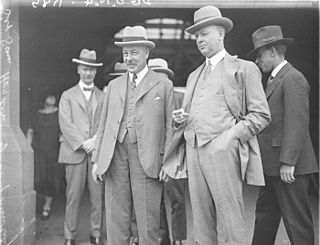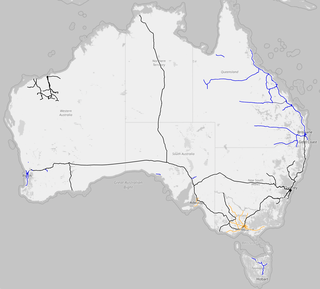
The Bank of New South Wales (BNSW), also known commonly as The Wales, was the first bank in Australia, being established in Sydney in 1817 and situated on Broadway. During the 19th century, the bank opened branches throughout Australia and New Zealand, expanding into Oceania in the 20th century. It merged with many other financial institutions, finally merging with the Commercial Bank of Australia in 1982 and being renamed to the Westpac Banking Corporation on 4 May that year under the Bank of New South Wales Act 1982.

George Fife Angas was an English businessman and banker who, while residing in England, played a significant part in the formation and establishment of the Province of South Australia. He established the South Australian Company and was its founding chairman of the board of directors.

Sir Samuel Hordern was an Australian businessman, animal breeder and philanthropist. Born into the prominent Sydney trading family, Hordern directed the family company of Anthony Hordern & Sons from 1909 to 1926.

Rail gauges in Australia display significant variations, which has presented an extremely difficult problem for rail transport on the Australian continent since the 19th century. As of 2022, there are 11,914 kilometres (7,403 mi) of narrow-gauge railways, 18,007 kilometres (11,189 mi) of standard gauge railways and 2,685 kilometres (1,668 mi) of broad gauge railways. In the 19th century, each of the colonies of Australia adopted their own gauges.

Since 1867, the British royal family has visited Australia over fifty times, with only six visits before 1954. Elizabeth II is the first and only reigning monarch of Australia to have set foot on Australian soil; she first did so on 3 February 1954, when she was 27 years old. During her sixteen journeys, the Queen visited every Australian state and the two major territories.

The Bank of Australasia was an Australian bank in operation from 1835 to 1951.
John Lazar was an actor and theatre manager in Australia. He was Mayor of Adelaide from 1855 to 1858.

Reginald John Burchell was an Australian politician. He was a member of the Australian House of Representatives for the seat of Fremantle from 1913 to 1922, initially for the Australian Labor Party and after the 1916 Labor split for the Nationalist Party.

Walter Langdon Parsons was an Australian politician.

The English, Scottish & Australian Bank Limited was an Australian bank founded in 1852 by Royal Charter in London and named English, Scottish and Australian Chartered Bank. Following a financial reconstruction in 1893 its business was renamed English, Scottish and Australian Bank Limited.

Wakefield Street is a main thoroughfare intersecting the centre of the South Australian capital, Adelaide, from east to west at its midpoint. It crosses Victoria Square in the centre of the city, which has a grid street plan. It continues as Wakefield Road on its eastern side, through the eastern Adelaide Park Lands.
The City of Port Adelaide was a local government area of South Australia centred at the port of Adelaide from 1855 to 1996.
The Australasian Institute of Mining and Metallurgy (AusIMM) provides services to professionals engaged in all facets of the global minerals sector and is based in Carlton, Victoria, Australia.

John Jackson Oakden, pastoralist, was an English explorer of South Australia, part of the European exploration of Australia, and a pioneer runholder of the Canterbury region of New Zealand.
The first Bank of South Australia was founded by the South Australian Company in the colony of South Australia in 1837 by British investors. It became defunct in 1892, when it was taken over by the Union Bank of Australia.
Hedley Allen Dunn was a South Australian architect, a member of the prominent Dunn family of Mount Barker. His work included the flour mill at Port Adelaide for his father and grandfather in 1886, and the Stock Exchange Building on McHenry Street, off Grenfell Street, Adelaide, in 1900.
Joseph Robertson MA was an Australian Congregationalist minister.

The former Westpac Building, also known as the Challenge Bank Building and the Western Australian Bank Building, is a heritage listed building located at 22 High Street on the corner with Mouat Street in the Fremantle West End Heritage area. It was one of many commercial buildings constructed in Fremantle during the gold boom period in the late nineteenth and early twentieth century.

May Gertrude Shepherd , was an Australian aviator and the first woman in Australia to hold first class pilot's 'A', 'B' and 'C' licences concurrently, in addition to a 'D' electrical ground engineers' certificate. She was also the first and the only woman in Australia, at the time, known to hold a 'X' certificate in oxy-welding and metallurgy.
Edward Angas Johnson, known as Angas or E. Angas Johnson, was City Health Officer of Adelaide, South Australia. His name has very frequently been misspelled as "Angus" Johnson.














